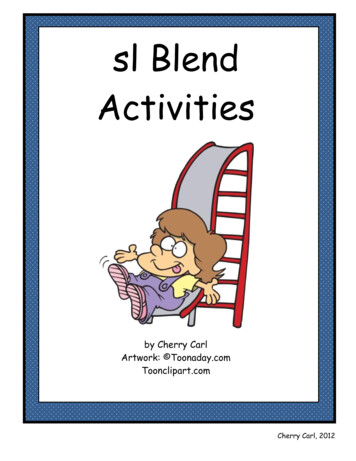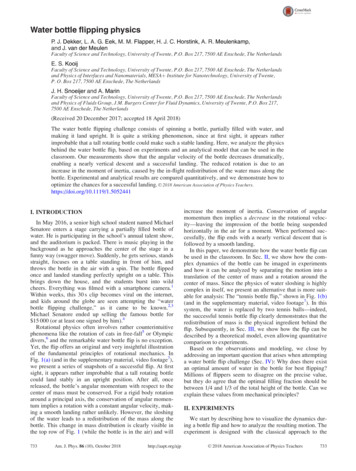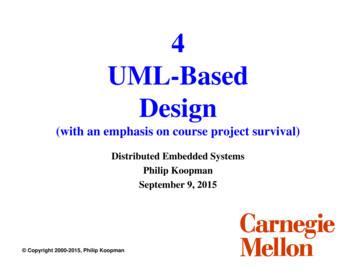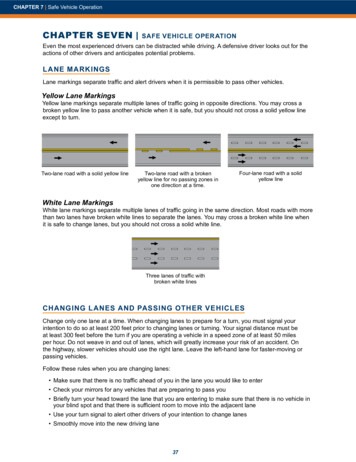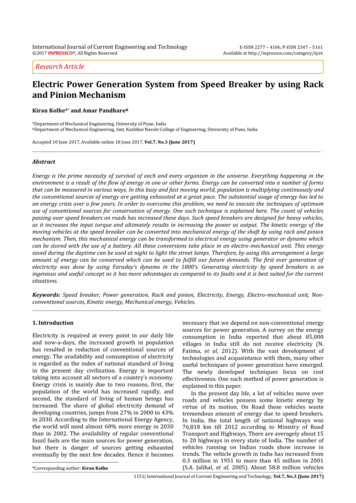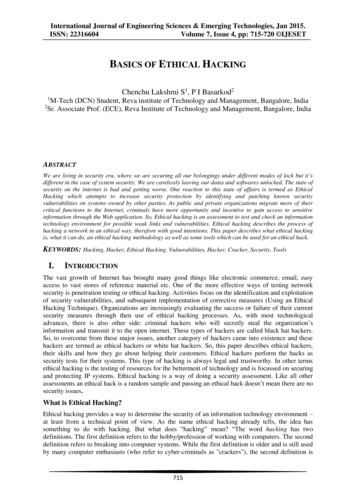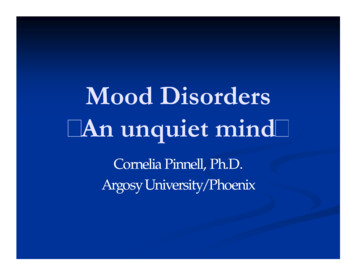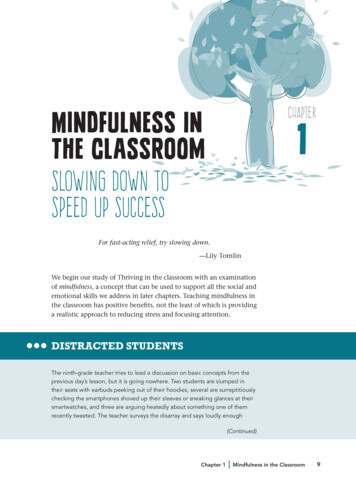
Transcription
CHAPTERMindfulness inthe Classroom1SlowIng Down toSpeed Up SuccessFor fast-acting relief, try slowing down.—Lily TomlinWe begin our study of Thriving in the classroom with an examinationof mindfulness, a concept that can be used to support all the social andemotional skills we address in later chapters. Teaching mindfulness inthe classroom has positive benefits, not the least of which is providinga realistic approach to reducing stress and focusing attention.DISTRACTED STUDENTSThe ninth-grade teacher tries to lead a discussion on basic concepts from theprevious day’s lesson, but it is going nowhere. Two students are slumped intheir seats with earbuds peeking out of their hoodies, several are surreptitiouslychecking the smartphones shoved up their sleeves or sneaking glances at theirsmartwatches, and three are arguing heatedly about something one of themrecently tweeted. The teacher surveys the disarray and says loudly enough(Continued)Chapter 1 Mindfulness in the Classroom 9
iStockphoto.com/adamkaz(Continued)to be heard over the noise, “Okay, people, let’s just calm down and take abreath—we’ve got a big review to cover for the upcoming test. I need you all tofocus.” The admonition is largely ignored, and the frustrated educator says tohimself, “Just a few more days, just a few more days . . .” as he longingly looksat his desk calendar to check how many days remain until fall break.In a classroom across campus, a primary teacher tries to rein in a rambunctiousgroup of students by saying, “Okay, I’ve had it with the racket. Most of you arenot paying attention. When I clap my hands, I want eyes on me. Stop fidgeting,stop looking out the window, and stop talking over each other.” She claps. Calmmomentarily prevails, but it takes less than fifteen seconds for the pandemoniumto resume. The teacher chants in her mind, “School is out in three more hours,school is out in three more hours . . .” as she reaches for an Advil.Later in their respective lounges, both teachers lament about how studentstoday are distracted and unfocused. One says, “I’m up there doing everythingbut tap-dancing on roller skates trying to get their attention, and nothingworks.” The other tells his colleagues, “I don’t know how I’m supposed tocompete with all their distractions and diversions. It’s like trying to hold thirtyballs under water at the same time.”Both of these teachers could improve their classroom environments andtheir own psyches with an inexpensive, readily available resource calledmindfulness. 10 Teaching Kids to Thrive Essential Skills for Success
Why Don’t They Just Pay Attention?Ask a group of educators about 21st century challenges to studentlearning, and among the top responses will be a lack of studentattentiveness. Competing forces from outside the classroom as wellas the wave of readily accessible digital devices have added a freshdimension of distraction. Those obstacles are compounded by theenduring challenges of engaging students who come from poverty,dysfunctional homes, and/or life-challenging circumstances that makethem unavailable for learning.School is often a difficult place in which to Thrive. It can be a noisy,chaotic place that stresses students, teachers, and administratorsalike. Today, schedules are packed tighter, recesses and breaks areoften suspended, course selection and availability are limited, andaccountability measurement tensions are amplified. Researchers referto extreme stress overload as toxic stress and have determined thatover time it actually reshapes the brain in negative ways. A 2014paper from the National Scientific Council on the Developing Childcompared stress overload to “revving a car engine for hours everyday. This wear and tear increases the risk of stress-related physical andmental illness later in life” (p. 2).Students of the 21st century live in a quick-fix world of instantgratification distracted by an onslaught of more information than anyprevious generation. They are bombarded with a never-ending streamof messages for most of their waking hours. Seldom are they giventime to be still and think. Feeling the pressure of high-stakes tests,teachers rush students through the mandated curriculum like it is asprint rather than a marathon.Adults are quick to admonish students to calm down and take abreath, but it seldom occurs to us that the act of taking responsibilityfor calming oneself is a skill that must be taught. Generally, whenwe ask or tell kids to be quiet for a period of time, it is for our benefitand not for theirs. When they complain about being bored, we handthem something to distract them rather than encourage them to takeadvantage of the downtime to pause and reflect on their situation.The model we adults present is the overworked, exhausted, stressedout grown-up who consistently complains that there’s so much todo and so little time to do it. Rarely do kids experience an adult whosays, “I’m feeling inattentive (or stressed), and I need to take a minuteto calm myself and regain my focus.”Chapter 1 Mindfulness in the Classroom 11
Daniel Goleman, psychologist and author of Focus: The HiddenDriver of Excellence (2013) and other best-selling books on socialand emotional learning (e.g., Goleman, 1995, 1998), says that hewould like to see schools teaching exercises that strengthen studentattention. He believes honing the ability to focus is a secret elementto success that often gets ignored. When interviewed by KatrinaSchwartz in 2013, he said,The more you can concentrate the better you’ll do onanything, because whatever talent you have, you can’t applyit if you are distracted. . . . This ability is more important thanIQ or the socio-economic status of the family you grew up infor determining career success, financial success, and health.If students don’t learn how to shut out distractions and centertheir attention, they are at risk of suffering both academically andphysically. They are setting themselves up for having serious problemsin many aspects of their lives both now and later on. How do wehelp our students learn to slow down, think things through, andpurposefully focus their attention?Mindfulness: What It Isand What It Is NotSince 2007, educators across the United States have been formallyintroducing students to a practice called mindfulness in the classroom.Most educators are familiar with the concept. It is hard to pick upa journal, attend a conference, or listen to a podcast about currenttrends in education that does not at least mention mindfulness. Type“mindfulness” into Google, and you get twenty-seven million hits.In 2012, Tim Ryan, a congressman from Ohio, published A MindfulNation and received a 1 million federal grant to teach mindfulnessin schools in his home district. Integrating the tenets of mindfulnesspractice in classrooms seems to have garnered increasing support.Research has shown that helping students learn how to self-regulatetheir behaviors through mindfulness has a pronounced positiveeffect on classroom management issues in terms of reduced conflictand bullying as well as on individual behavior such as controllingimpulsivity and attentional focus. Of course, mindfulness is notwithout its detractors, but the research on its positive impact on both12 Teaching Kids to Thrive Essential Skills for Success
social and emotional learning as well as on academic achievement ispromising.You may be in a school that practices school-wide mindfulness, youmay already have a program in place in your classroom for teachingand practicing it with your students, or you may have just heardabout it and want to give it a try. (And you may be reading this andasking yourself, “What is mindfulness? Is it just another educationalfix du jour?”)Pause Your Reading and Try ThisPause(Seriously, don’t skip this part. Actually do it! It just takes two minutes.)Take one hand and gently tap your thumb to each finger on the same hand.Think only about what you feel as you alternate finger taps. If your mind driftsto other things, just gently bring it back to your fingers. Notice but disregard allother fleeting thoughts. Focus on your fingertips. How do they feel right now?After a minute or two, relax your fingers and take note of any differences youfeel in your hand. If you closed your eyes during this exercise, open them. Gentlystretch your entire body and reflect on what just happened. If you have neverdone a mindfulness exercise before, congratulations—you’ve just completedyour first one!Mindfulness is not new. Generally, it is acknowledged as being basedon age-old practices from the time of the Buddha, but some scholarsbelieve that similar practices were advocated as well in Christian,Jewish, and Muslim teachings. Originally, it was grounded in religiouspractices, but most of today’s researchers and practitioners are focusedon the more secular applications of its short-term effect on selfregulation and its long-term impact on the neuroplasticity of thebrain. The mindfulness practices we are advocating are not tied to anyreligious affiliation; they are proven ways to help adults and studentsalike prepare mentally to better handle distractors in daily life. Theyare not meant to be a new relaxation technique or a hippy-dippyesoteric fad. The activities we present offer students and the adultswho teach them a way to calm the emotional center of the brainthrough nonjudgmental and nonreactive awareness.The concept of mindfulness is gaining recognition in the fields ofneuroscience and psychology and is also expanding its traction witheducators and parents as a way to help learners grow and controlChapter 1 Mindfulness in the Classroom 13
their brains in a particular way. Mindfulness is a way of learning tobe fully present in the moment without being distracted by pastanxiety or future uncertainties. It is a way to become aware of ourhabitual reactions and emotional triggers as we practice a methodfor calming our minds and bodies. The basics are very simple butare not all that easy.Using Mindfulness in the ClassroomIn mindfulness exercises, we encourage students to practice limitingtheir focus to their breathing and/or a single concrete thing. Theinstruction will inevitably have students breathe deeply and thinkonly about their breath as it enters and leaves the body—to focus onthe here and now, not what might have been or what they’re worriedcould be. The ultimate goal is to give them enough distance fromdisturbing thoughts and emotions to be able to observe them withoutimmediately reacting to them.In the beginning, the exercise should last no more than a minute ortwo. We tell our students their thoughts will naturally wander but tobe aware of that and gently bring their attention back to the task athand. We let them know they should not judge themselves or theirthoughts but rather just take note of what is going on and redirecttheir focus. It is important to let them know this is not an easyprocess but it will become easier with practice.We need to debrief students often in the beginning to get them totalk about how different things popped into their minds or maybehow they suddenly realized they have a pain somewhere or thatthey are hungry or cold or tired. Have a conversation with themabout how the mind fills us with thoughts and messages that arenot necessarily true but may just be a voice of concern or guilt orapprehension. For instance, a person should not say to himself,“Oh, I really shouldn’t be thinking this particular thought. I mustbe a bad person.” Instead, the learner might say, “Wow, that’s astrange thought. I wonder where that came from,” while continuingto return to the focused objective. Students are to notice but notjudge thoughts. Tell them the goal is to watch your thoughtswithout identifying with them, much like sitting beside the roadand watching cars go by. Sometimes you jump in one of them and ittakes you down the highway, but then you remember your purpose,get out, and watch cars passing by you again.14 Teaching Kids to Thrive Essential Skills for Success
Eventually, students will begin to be aware of body and mindmessages constantly vying for attention. By increasing awareness ofinternal mental and physical states, mindfulness can help peoplegain a greater sense of control over their thoughts, feelings, andbehavior in the present moment. By paying closer attention to thesensations they feel when they are anxious, angry, threatened, or thelike, they learn to recognize certain triggers and also how to controltheir automatic reactions to those feelings. Ultimately, students learnto understand that they do not have to react or respond to everythought they have. They begin to realize they are strong individualswho can calm themselves, think things through, and consciouslychoose a course of action.Beginning a Mindfulness PracticeYou may already be practicing mindfulness yourself, and you may beexperienced in integrating this practice into your classroom. Or youmay be saying to yourself, “That’s an interesting idea, but I have noidea where to start. I wonder how it’s done, what it takes, and if itreally works.” In the Thrive Skills in Action section of this chapter,we offer a few of the more popular mindfulness activities along withsome basic strategies we think will help you in any classroom. Wehighly recommend that you watch the video Room to Breathe as a staffdevelopment activity and discuss the possibilities for your school.Sometimes teachers begin with a very simple breathing exercise. Thebreathing exercises in mindfulness are a strategic way to teach learnershow to check in with what they are actually feeling. So many childrenare caught up in a state of constant stimulation and unexaminedaction–reaction response that they are oblivious to what is actuallygoing on in their brains and the rest of their bodies. Intentionalbreathing prompts them to slow down, tune in to the present, andtake a mental note of how they feel.It is important to stress to students that this activity should benonjudgmental. They need to try and push away any thoughtsof self-labeling, shame, or guilt. The purpose of mindfulness is tosimply acknowledge what is going on and be aware of it. Later in thisbook, we will examine how this awareness can bring about a highersense of gratitude, more self-regulation, and better decision making,but first things first. Practicing the ancient art of mindfulness is acrucial skill for helping students improve their lifelong Thrive skills.Chapter 1 Mindfulness in the Classroom 15
iStockphoto.com/WavebreakmediaROOM TO BREATHEThe movie Room to Breathe is about troubled students at Marina MiddleSchool in San Francisco, California. The film presents a true story of thesurprising transformation of struggling seventh graders in a school thathas a high rate of disciplinary suspensions, overcrowded classrooms, anda markedly negative learning environment. One classroom of students isintroduced to the practice of mindfulness meditation in an effort to providethem with social, emotional, and attentional skills they need to succeed. Ateacher from the Mindful Schools organization persists in introducing themto mindfulness in spite of their initial resistance and markedly unenthusiasticresponse. She meets with the students for thirty minutes a week over a sixweek period. Her first goal is to get students to become still and quiet whenthey hear a chime. Even that simple task seems to be at first unachievablefor some. By the end of the program, she has the students applying thebreathing techniques they learn in class to situations both inside andoutside the school. At the end of the training, these same students reportthey are better able to control their anger, more focused on schoolwork,and more tolerant of each other, and they feel more in control of theirfutures. To watch the video, visit www.mindfulschools.org/resources/room-to-breathe 16 Teaching Kids to Thrive Essential Skills for Success
The important first step for teachers is to plan a time to implementmindfulness activities on a regular basis in their classrooms. Thereare plenty of YouTube videos, phone apps, articles, and otherresources to help with specific procedures and routines. We presentsome of our favorites in this book and on the Thrive website(www.teachingkidstothrive.com).Research on Mindfulnessin the ClassroomYoga, Tai Chi, and Csikszentmihalyi’s (1990) theory of flow are basedon some of the same tenets of focused attention. Mindfulness astaught in schools usually focuses on concentrating, breathing, andmaking conscious choices. Ronald D. Siegel (2014), a psychologist andHarvard professor, cites study after study of hard science that supportsthe benefits to individuals (including children) who are being taughtthe practice of learning to pause and reflect before acting. He andother researchers have found that mindfulness practice over timeactually changes the way the brain is formed. His catch line is Hebb’srule, “Neurons that fire together, wire together.” In other words,people can actually help their prefrontal cortex to function moreeffectively over time with intentional practice of mindfulness.Other neuroscientists also find that the permanent structure ofthe brain can be improved through mindfulness practices. Worldrenowned neuroscientist Richard Davidson at the Center for HealthyMinds at the University of Wisconsin–Madison, along with hiscolleagues, wants us to know three things: (1) You can train yourbrain to change, (2) the change is measurable, and (3) new ways ofthinking can change it for the better (Wolkin, 2015).Davidson believes we can potentially influence the plasticity of ourbrains by focusing on skills and habits that benefit our well-being.Along with other measurable changes that have been observed,laboratory studies show the amygdala (center of our “fight, flight,or freeze” reactions and emotional control center) actually shrinksafter sustained mindfulness practices. The connections between theamygdala and the prefrontal cortex are weakened, which allows lessreactivity and paves the way for connections between areas associatedwith higher-order brain functions (such as concentration andattention).Chapter 1 Mindfulness in the Classroom 17
Mindfulness is being studied as a countermeasure for use withstudents presented with such challenges as autism, attention deficit/hyperactivity disorder (ADHD), attention deficit disorder (ADD), andan array of behavioral issues. Carolyn Gregoire (2014) reports thatmindfulness practices have resulted in “increased mindful awarenessamong both parents and children, and reduced parental stress.”While writing this chapter, we thought about how few times weactually practiced mindfulness as classroom teachers. Most of ourclassroom time was centered on lecture, group experiences, hands-onactivities, and a rather frenzied pace to “get it all done” in our fortyfive-minute class periods. Only rarely did we give our students time todisconnect from our fast-paced activities and hear themselves think.On one occasion, we took science students outside and asked themto select a tree that drew their attention, observe it, sketch it, andwrite something about it. Just sitting quietly and gazing at their treeselections had a profound effect on our middle-level students. Someactually had tears in their eyes as they begged to be allowed to just sitand be still for just a little longer.We see now that in our efforts to hurry up and cover the mandatedcontent we missed an opportunity to teach our students theimportant lifelong skill of being able to stop, breathe, and thinkabout their thinking. The simple act of pausing to connect with one’sthoughts in a focused, nonjudgmental setting can yield remarkablefeelings of awareness and control. Simply being able to label feelingsand realize one has a conscious choice about whether or not to act onthose feelings is empowering.So many of our students come to school after having experienced atumultuous morning at home, bullying on the bus, or any numberof distracting and upsetting factors. By giving kids a fresh start witha mindfulness activity, we help create better conditions for learning.As Argos Gonzalez, an English teacher at an alternative school inNew York, put it, “If you don’t address the noise in a kid’s headthat they bring from the outside, I don’t care how good a teacheryou are, you’re not going to have much success” (Davis, 2015). Thefundamental purpose is to help students learn to calm themselves andclear their minds so they can better focus on the lesson at hand. It isvery much like training their “attention muscles.”Mindfulness is a commonsense lifestyle habit like brushing yourteeth, exercising, or eating the right kinds of food. It is somethingthat can be taught to every student. It offers educators a chance toreset the climate when chaos occurs or when tensions run high (for18 Teaching Kids to Thrive Essential Skills for Success
HEALING TRAUMAWITH MINDFULNESSIn 2009, second-year principal Lana Penley was trying to find a way to healthe trauma caused when her 460 students and 50 staff members were herdedfrom their burning school building to a sports field nearby. Later housed in avacant school building across town for three years during the rebuild, Penleywas concerned about the impact of the ordeal on her many at-risk students.The staff decided they would have to find a social and emotional curriculum toconnect with the hearts of all who were affected. They tried many ideas fromGoldie Hawn’s MindUP program, but Penley noted the real change camefrom a simple shift in having teachers start each class in the morning with a fewbreaths to help students feel present. In the middle school, students did theirbreathing exercises after each passing period. Teachers began to embrace theconcept of mindfulness and to use it for enhancing other Priority AcademicStudent Skills (PASS). The changes in tone and culture were dramatic. Disciplinereferrals dropped, teachers are happier, and this Title I school now has onehundred applicants for every open position (Schwartz, 2016a). example, before a major test). Hopefully, schools will also embracethis relatively cost-free means of helping teachers and studentsdevelop positive, life-changing ways to think, relate to each other,and act in ways that help them Thrive. Jennie Rothenberg Gritz,in her article “Mantras Before Math Class,” describes the beneficialeffects of mindfulness practices in a school located in an area of SanFrancisco with the highest rates of violent crime. Within four years,the suspension rate dropped to one of the lowest in the city. “Dailyattendance rates went up to 98 percent, and the students’ overallgrade point average showed marked improvement. This formertroubled school now ranks first on happiness inventories administeredthroughout the district” (Gritz, 2015).Implementation in the ClassroomAt this point, those new to mindfulness usually ask questions like“But what does it look like in an actual classroom?” “What do I do ifI have tables instead of chairs or no space for students to spread out?”“How often do I use it, and how long does it take?” Mindfulness inChapter 1 “”How you addressmindfulnessneeds to be theway that bestsuits you, yourstudents, andyour school.Mindfulness in the Classroom 19
the classroom is an evolving practice that has only been used widelyin the last ten years. The short answer to all those questions is thathow you address mindfulness needs to be the way that best suits you,your students, and your school. Educators have chosen a wide array ofmaking the concept work for their students. This is just a partial list ofthe variety of ways mindfulness has been implemented in classrooms:1. Certified trainers are brought in at designated times duringthe week to work with students and teachers.2. Teachers go through specific training and are then put incharge of leading their own students in mindfulness practices.3. Classroom teachers set aside time every morning and everyafternoon for mindfulness practices.“”A high school inMassachusetts setup a mindfulnessroom, “offereddaily from 9 a.m.to 2:30 p.m.,complete withyoga mats,blankets, tranquilmusic and softlighting, staffedby teacherstrained inmindfulnessto guide thestudents duringtheir studyhall breaks”(Wallace, 2016).4. Middle and high school teachers begin each class with a fewminutes dedicated to time for mindfulness. Thirty-minutesessions are offered three times a week.5. A single forty-five-minute session is offered once a week.6. A guided mindfulness practice is conducted in a high schoolfor half an hour twice weekly.7. In Britain, teachers follow a scripted program for ninelessons. Once students internalize the process, teachers andadministrators use quick mindfulness practices whenever theythink they are needed.8. Schools in California and New York voted to add thirtyadditional minutes to the school day to implement amindfulness program called Quiet Time (Gritz, 2015).9. Counselors visit classrooms and conduct mindfulness activities.10. Parents are encouraged to take mindfulness training offeredby the school.11. Regular mindfulness practice can be just moments of stillnessor silence.Mindfulness practice can be formal or informal. No matter howyou choose to implement a mindfulness practice, the goal is to helpstudents of all ages learn they can use it anytime they need to refocustheir attention or reset their thoughts. They soon realize they havethe power to check in with their bodies at any time, figure out whatis going on, and restore the balance they need to best handle thesituation at hand.20 Teaching Kids to Thrive Essential Skills for Success
What Supporting MindfulnessLooks Like in the ClassroomBE AWARE OF THE PART YOU PLAY IN SETTINGTHE PACE AND TONE OF YOUR CLASSROOMStudents feed off of the energy of the teacher and the room.Whenever possible, start the day alone in your classroom with nodistractions. Take a few minutes just to breathe deeply and focus onyour purpose. Let go of the distractors—the tire that probably needsair in it or the colleague who just stepped on your last nerve—and befully present for the students who will soon be right there, right now.START EACH CLASS OFF WITHTHE RIGHT ATMOSPHEREAs students enter the classroom, position yourself at the door or nearthe front to greet students and offer a sincere welcome. Calmingmusic could usher them in, and taking a moment to start off with afocus activity can pay big dividends.REMEMBER THAT MINDFULNESSIS NOT MANDATORYWhen using mindfulness in the classroom, don’t push studentsbeyond their comfort level. Students can choose to participate or not.There is no judging. Some may wish to gaze out the window or puttheir heads down. The one requirement is that they do not disturb ordistract others during the activities. Some may be open to describingfeelings, and some might not be. Don’t use the mindfulness area orany mindfulness activity as punishment. Students should see the actof being still and thinking as something that is positive and helpful.BE A GOOD MARKETERWhen teaching mindfulness (especially to middle school and highschool students), it is helpful to sell it to your students and create abuy-in before you start your program. Explain to students why you areteaching the technique and what it can do for them. Start by havingthem discuss the stresses in their lives (see Activity 1.5, “Up in theAir,” at the end of this chapter). You may want to share how thesetechniques have been used successfully in other schools. You mightChapter 1 Mindfulness in the Classroom 21
want to talk about how you use these techniques personally. You canalways close with the question, “What have you got to lose?” Encourageyour students to try just a few short techniques and see how they work.KEEP IT SIMPLEFor younger students, don’t overwhelm them with lots of complexterms for mindfulness. Keep it simple. Concentrate on breathing andfocus. Present ideas in relation to the senses. “What do you hear, smell,feel?” In the beginning for all ages of students, plan to spend a lot oftime debriefing to ensure they understand the purpose of the practice.PRACTICE, PRACTICE, PRACTICEStudents need to have consistent, ongoing opportunities to practicetraining in focus and mindfulness. This is not a stand-alone activityyou can do at the beginning of the year and forget. Early ed teacherscan use an activity called “Breathing Buddies” (described on theThrive website at www.teachingkidstothrive.com). Teachers of middleand high school students can regularly conduct three- or five-minutebreathing exercises. As they gain confidence in the procedures,students can take an active role in leading mindfulness activities.USE MINDFULNESS YOURSELFPractice mindfulness activities both with your students and when youare alone. Try to find a mindfulness buddy or buddies at school toshare ideas and support.SET UP A MINDFULNESS AREA ORSTATION IN OR NEAR YOUR CLASSROOMCreate a place that students can visit when they feel the need toregain their composure, their focus, and/or their sense of well-being. Itcan be as simple as a chair, headphones, a blanket, and items that actto soothe (a squishy ball, a density column, Wooly Willy, worry beads,a stuffed animal). Talk with students ahead of time about suitabletimes to use the station and appropriate behavior choices while there.START EACH CLASS WITH AT LEAST A COUPLEOF MOMENTS OF GUIDED MINDFULNESSRoutinely remind students to put all other concerns on hold and prepareto focus on what is happening here and now. Offer them a moment tobreathe deeply, relax, and choose how they will respond to today’s class.22 Teaching Kids to Thrive Essential Skills for Success
Frequently Asked Questions1. Isn’t having educators teach mindfulness trainingrather like asking us to become therapists?Teachers have always served many roles including nurse,counselor, surrogate parent, coach,
Mindfulness in CHAPTER 1 the Classroom SlowIng Down to Speed Up Success For fast-acting relief, try slowing down. —Lily Tomlin We begin our study of Thriving in the classroom with an examination of mindfulness, a concept that can be used to support all the social and emotional skills we address in


